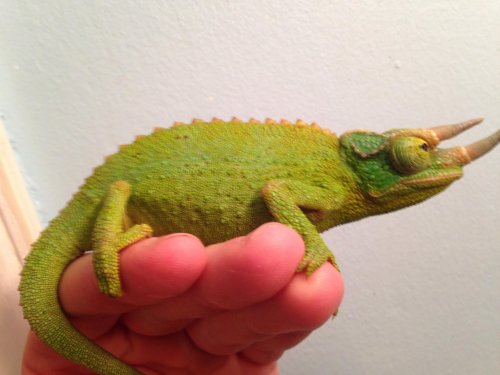ChameleonRugby
New Member
Hello Everyone,
I have recently become the owner of a Jackson chameleon and would really appreciate it if I could receive some help considering that most members of this site seem very experienced in dealing with chameleons. Keep in mind this is my first pet chameleon and unfortunately I did very little research on the subject before I purchased my pet and I now feel as though I am not providing him with sufficient care. I really want to do everything I can for my chameleon and hope it lives a very long enjoyable life.
My first major concern is the health of my chameleon I will post some pictures along with this thread but there are a few things I am worried about. The first one is there appear to be brown spots on the joints of his skin and his skin overall appears very loose at times which from what I have looked up might be signs of dehydration and second my chameleon appears to have stopped eating the crickets I am feeding him I am concerned that this May be because the crickets are too big or I have read that he may be bored with that type of food . One of my biggest concerns with his cage is that I have difficulty keeping the humidity above 50 percent and I think this May be what is causing his dehydration I just recently put a live pothos plant in his cage because all of his other plants are plastic but I also have drip system for him.
So basically I would find it extremely helpful if you could take a few moments too look at the pictures I am posting and give some tips on how healthy he appears and if you can think of anything that may improve his over all being. I really hope to keep my new pet alive for many years to come and become a reasonable expert on this exotic pet that so I may be able to raise and take care of many more down the road. Thank you all in advance for your assistance.
I have recently become the owner of a Jackson chameleon and would really appreciate it if I could receive some help considering that most members of this site seem very experienced in dealing with chameleons. Keep in mind this is my first pet chameleon and unfortunately I did very little research on the subject before I purchased my pet and I now feel as though I am not providing him with sufficient care. I really want to do everything I can for my chameleon and hope it lives a very long enjoyable life.
My first major concern is the health of my chameleon I will post some pictures along with this thread but there are a few things I am worried about. The first one is there appear to be brown spots on the joints of his skin and his skin overall appears very loose at times which from what I have looked up might be signs of dehydration and second my chameleon appears to have stopped eating the crickets I am feeding him I am concerned that this May be because the crickets are too big or I have read that he may be bored with that type of food . One of my biggest concerns with his cage is that I have difficulty keeping the humidity above 50 percent and I think this May be what is causing his dehydration I just recently put a live pothos plant in his cage because all of his other plants are plastic but I also have drip system for him.
So basically I would find it extremely helpful if you could take a few moments too look at the pictures I am posting and give some tips on how healthy he appears and if you can think of anything that may improve his over all being. I really hope to keep my new pet alive for many years to come and become a reasonable expert on this exotic pet that so I may be able to raise and take care of many more down the road. Thank you all in advance for your assistance.



